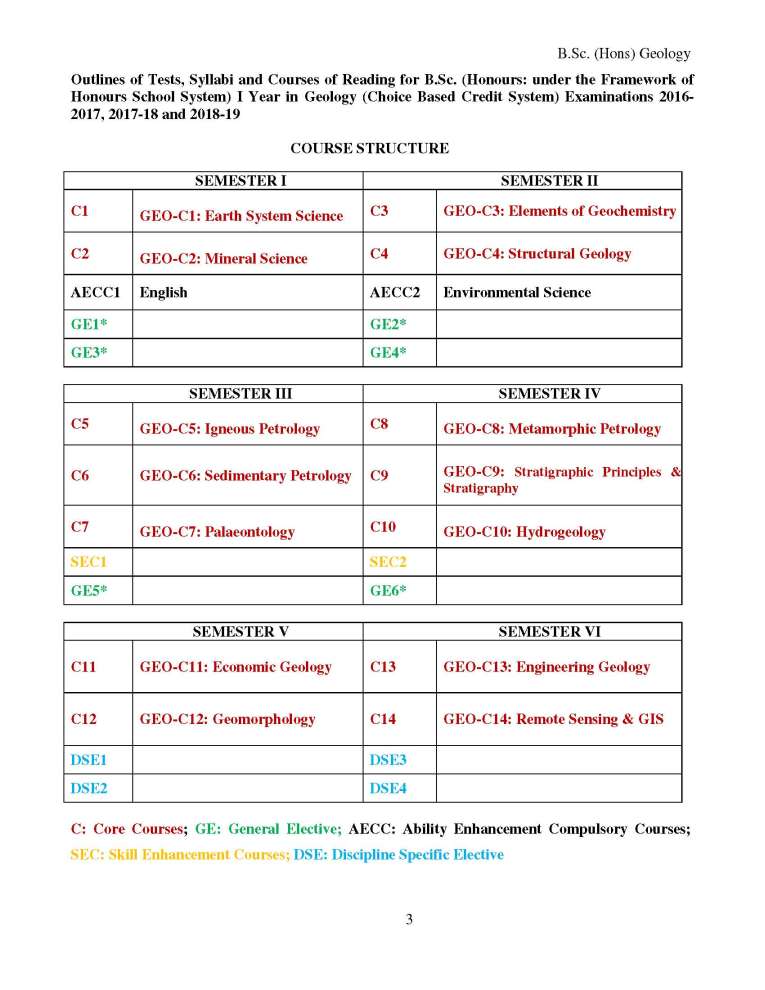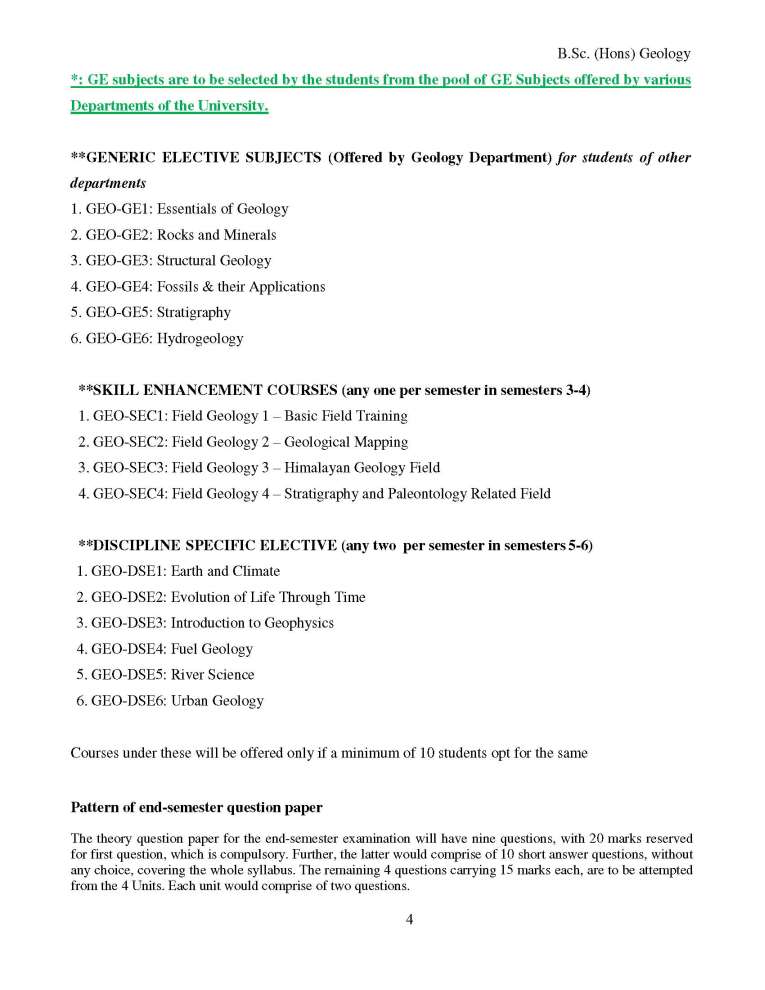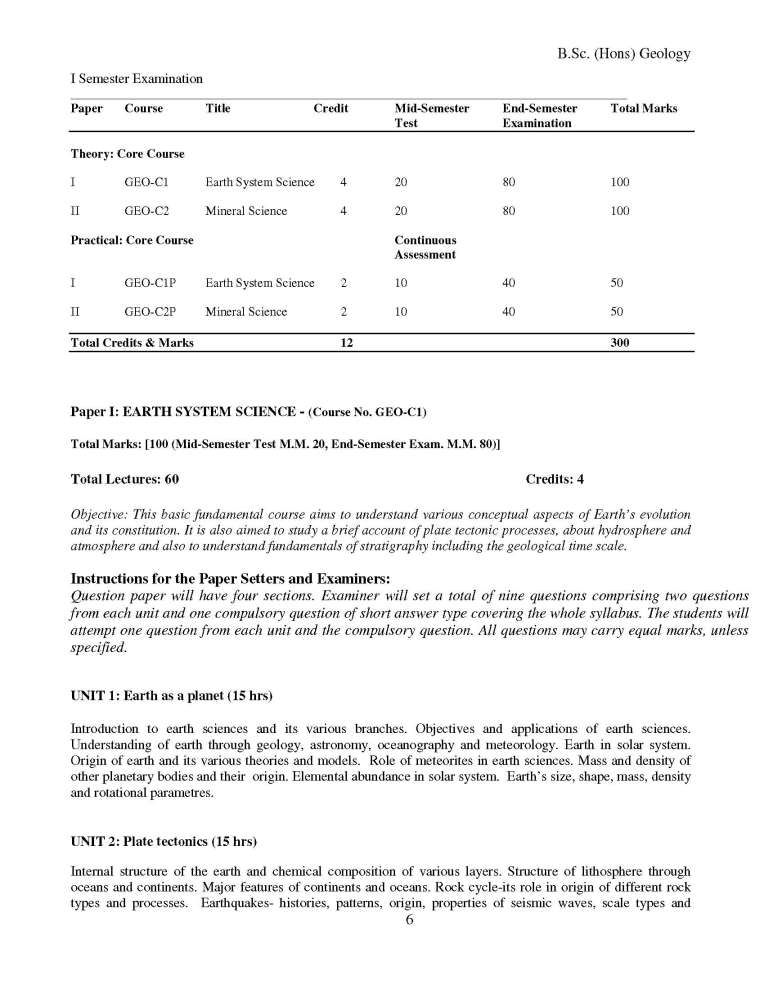|
#3
5th March 2020, 08:54 PM
| |||
| |||
| Re: Past Papers Of Geography Bsc Punjab University
The syllabus for Bachelor of Science (BSc) (Hons) Geology Program offered by Panjab University is as follows: B.Sc. (Hons.) Geology I Year Semester I and II Paper I: EARTH SYSTEM SCIENCE - (Course No. GEO-C1) Total Marks: [100 (Mid-Semester Test M.M. 20, End-Semester Exam. M.M. 80)] Total Lectures: 60 Credits: 4 Objective: This basic fundamental course aims to understand various conceptual aspects of Earth’s evolution and its constitution. It is also aimed to study a brief account of plate tectonic processes, about hydrosphere and atmosphere and also to understand fundamentals of stratigraphy including the geological time scale. Instructions for the Paper Setters and Examiners: Question paper will have four sections. Examiner will set a total of nine questions comprising two questions from each unit and one compulsory question of short answer type covering the whole syllabus. The students will attempt one question from each unit and the compulsory question. All questions may carry equal marks, unless specified. UNIT 1: Earth as a planet (15 hrs) Introduction to earth sciences and its various branches. Objectives and applications of earth sciences. Understanding of earth through geology, astronomy, oceanography and meteorology. Earth in solar system. Origin of earth and its various theories and models. Role of meteorites in earth sciences. Mass and density of other planetary bodies and their origin. Elemental abundance in solar system. Earth’s size, shape, mass, density and rotational parametres. UNIT 2: Plate tectonics (15 hrs) Internal structure of the earth and chemical composition of various layers. Structure of lithosphere through oceans and continents. Major features of continents and oceans. Rock cycle-its role in origin of different rock types and processes. Earthquakes- histories, patterns, origin, properties of seismic waves, scale types and effects of earthquakes. Volcanoes- structure, types and products. Distribution of belts of earthquake and volcanoes. Plate tectonics and sea floor spreading. Evidences of plate processes. UNIT 3: Hydrosphere and atmosphere (15 hrs) Weathering and erosion: types and factors controlling erosional processes. Exogenic processes associated with various features of erosion, transportation and deposition of rivers. River profiles. Role of groundwater in hydrological cycle. Groundwater flow in relation to sediment properties and textures. Exogenic features of erosion and deposition of groundwater. Distribution and types of glacial belts. Glacial erosional and depositional features and their origins. Aeolian action related to origin and distribution of deserts. Sand dunes-origin and geometries. Erosional, transportational and depositional features in major deserts of the world. Oceansdistribution and application in global climates and hydrospheric cycles. Types of oceanic waves. Erosional, transportational and depositional processes and relief features resulting from wave action. Soils-origin and types. Landforms related to soils. Climatic changes and role in controlling geomorphology UNIT 4: Understanding the past from stratigraphic records (15 hrs) Introduction to stratigraphy- scope, objectives and applications in geology. Uniformitarianism and catastrophism. Concept of stratigraphic correlation and techniques. Fundamentals of stratigraphic classification and applications in earth histories. Concept of geologic time scale through geologic and evolutionary episodes. Geochronologic, radiometric and relative methods of dating. Introduction to geomorphology. Stratigraphic and age-wise chronology of major geologic and palaeontologic histories in India. Stratigraphic successions, fossils and ages of Precambrian and Phanerozoic basins. SUGGESTED READING 1. Brown, G.C. and Baily, W. (1981). Earth Science. 2. Duff, D. (1992). Homes’ Principles of Physical Geology, 4th Ed. Chapman & Hall. 3. Emmons, W.H. Allison, I.S. Stauffer, C.R. and Thiel, G.A. (1960). Geology: Principles and Processes. McGraw Hill. 4. Foster, R.J. (1988). Physical Geology. 5. Gass, I.G. Smith, P.J and Wilson, R.L. (1979). Understanding the Earth – A Reader in Earth Science. 2nd Ed. 6. Hamblin, W. K. (1996). Introduction to Physical Geology. McMillan Publishing Company. 7. Levin, H.L. (1995). Contemporary Physical Geology. Saunders College Publishing. 8. Leet, L.D. and Judson, S. (1969). Physical Geology, 3rd Ed. Prentice Hall of India, New Delhi. 9. Leet, L. D., Judson, S. and Kauffman, M.E. (1992). Physical Geology. Prentice – Hall. 10. Monroe, J.S. and Wicander, R. (2003). Physical Geology. Books/Cole, Thomnson Learing, Australia. 11. Tarbuck, F.K. Lutgens. (2015). Earth Science, Prentice-Hall. Syllabus for BSc (Hons) Geology Program Panjab University    |